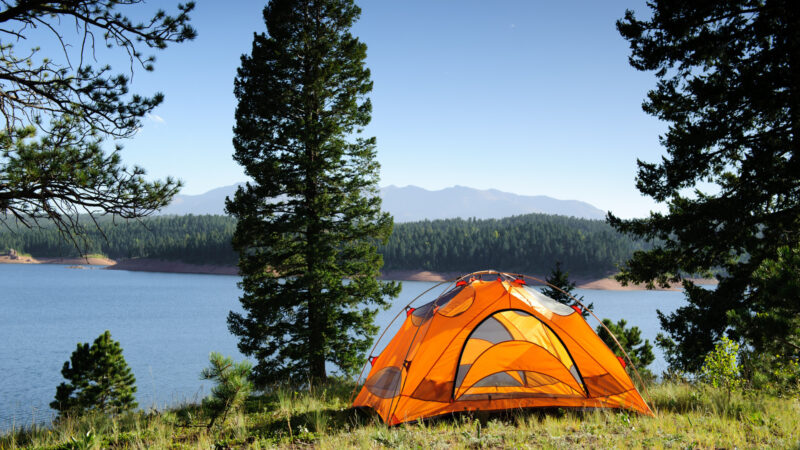Table of Contents Show
A reliable and durable tent can help ensure an enjoyable and comfortable camping experience.
However, many people overlook the importance of a tent footprint when packing their gear. It doesn’t matter where you camp; not having one can set your entire trip up for failure.
So what are they, and why do you need one? We’ll dig into it today, answer some common questions, and share the benefits of using them.
Let’s get started!
What Is a Tent Footprint?
A tent footprint is a piece of material that goes underneath your tent. It provides a layer of protection between the floor and the ground. They’re made of durable materials such as nylon or polyester to help them withstand wear and tear from rough terrain, rocks, and twigs.
They often use metal grommets or attachment points so that you can secure them to the ground with stakes. This helps them stay in place and avoid issues, especially with the wind.
By using a tent footprint, you can extend the life of your tent, prevent damage to the floor, and create an additional layer against moisture, dirt, and insects. It’s a crucial outdoor gear that every camper should consider adding to their packing list.
- A MUST FOR TENT: An extra tent tarp doesn't just give you extra waterproofing, it is used as ground cloths under tents...
- HEAVY DUTY: A tough groudsheet that can be easily overlooked but it makes all the difference when setting up the...
What Size Tent Footprint Do You Need While Camping?
The size of the tent footprint you need depends on the size of your tent. It should be smaller than the base of your tent to avoid potential water issues. Always check the specifications or dimensions to confirm compatibility.
If you can’t find this information, set up your tent and use a tape measure to get the dimensions. You can purchase materials and cut them to size to meet your needs. Some manufacturers offer custom options designed specifically for their products.
Can You Use a Tarp as a Tent Footprint?
You can use a tarp as a tent footprint in a pinch. Tarps are durable, waterproof, and can serve as a protective barrier. This protects your tent from rocks, sticks, moisture, and other potential hazards.
However, a tarp doesn’t always guarantee total coverage. Depending on the size of your tarp and shelter, you may need to use multiple tarps.
Additionally, the edges may stick out if the tarp is too large. If it rains, this can become an issue as it allows water to gather and eventually find its way inside.
- Multi-purpose outdoor tarp is great for covering items or placement under a camping tent
- Waterproof design made of durable rip-stop fabric with polyethylene lamination on both sides
Should You Camp Without a Tent Footprint?
While it is possible to camp without a tent footprint, we don’t recommend it. We consider them an essential piece of gear you should add to your packing list.
Without one, you’re leaving the floor of your tent vulnerable to rips and tears. This drastically decreases its lifespan, and you certainly don’t want to replace expensive equipment any sooner than you have to.
Additionally, they can help keep your camping gear clean. If you plan to camp in muddy or dusty areas, you’ll want to have one. They can help you leave mother nature behind at the end of your trip.
Keep in Mind: Are Walmart Camping Tents Any Good? Let’s look and see!
Benefits of a Tent Footprint
If trying to decide whether or not you should use a tent footprint, we have listed a handful of benefits. Here are some reasons we think you should always use one no matter where you camp.
Protection
A tent footprint is a critical accessory for protecting the delicate materials used during the construction of your tent. Manufacturers strive to create the lightest and most compact equipment possible.
Unfortunately, they can become damaged or worn easily, leading to holes or tears. These can lead to water seeping in, creating a wet and uncomfortable camping experience. Trust us; it’s all downhill once your stuff gets wet.
Easy Cleaning
Tent footprints can also help to keep your shelter clean. When you camp, dirt, mud, and debris can easily get inside, making it difficult to clean and maintain. They create an extra barrier between the ground and your tent.
A tent footprint can also protect you from moisture, often leading to mold and mildew. Mold thrives in damp environments; it can be difficult to remove once it appears. You can clean and dry tarps and coverings easier than a large tent, making it simple to maintain a clean environment.
Moisture Barrier
One of the primary reasons people use tent footprints is to serve as a moisture barrier. They prevent water from getting into your tent.
When you camp on damp ground, moisture can easily penetrate your floor, making your living space wet and uncomfortable.
An extra layer between the floor and the ground can prevent moisture from seeping into your tent. This can help to keep your sleeping area dry, even during heavy rains.
Environmental Impact
If you want to protect the ground underneath you while camping, these can do just that. They help to preserve the natural landscape and reduce your impact on the ground. This prevents you from damaging soil and protects the plants and other vegetation growing there.
Insulation
Tent footprints can also serve as an additional insulation layer against cold and damp ground. When the temperature drops at night, the ground becomes extremely cold. This can make it challenging to stay warm.
In these situations, another insulation layer can help keep you warm and comfortable throughout the night.
This is especially important if you camp in colder climates or during the fall or winter months when temperatures can drop significantly. Even with a high-quality sleeping bag, an extra insulation layer never hurts.
Pro Tip: RV insulation is essential for having the best RV experience! See what type is right for you with our ultimate guide.

Use a Tent Footprint and Camp Like a Pro
Whether you’re an experienced camper or a beginner, using a tent footprint is a simple and effective way to camp like a pro.
You can avoid damage, prevent moisture from seeping into your living space, and provide an additional layer of insulation against the cold and damp ground.
Before your next camping trip, invest in a tent footprint to protect your gear and enhance your overall camping experience. Trust us; you won’t regret it!
Last update on 2025-01-19 / Affiliate links / Images from Amazon Product Advertising API








